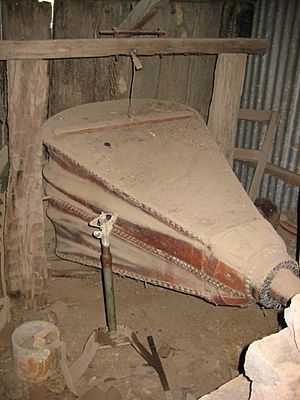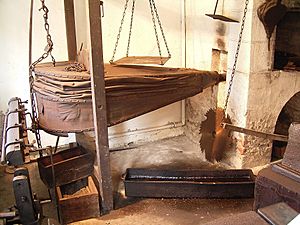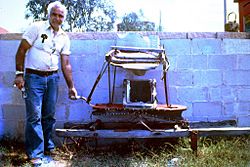Bellows facts for kids

A bellows is something that blows air into a small opening in order to make something work. The bellows will have a kind of sack which has air in it. When the sack is squeezed the air is pushed out. Bellows can be quite small and operated by hand, for example for stoking a fire in an open fireplace. They can also be very large, such as bellows that produce air for a large pipe organ to be played. Such bellows used to be pumped by hand (sometimes by several people), but nowadays electricity is used. Bellows are used by blacksmiths or metalworkers for smelting and welding. They are also used in small musical instruments such as bagpipes, accordions and concertinas. The harmonium has bellows which the player operates by pumping with the his feet.
Contents
Name


"Bellows" is only used in plural. The Old English name for 'bellows' was blǽstbęl(i)g, blást-bęl(i)g 'blast-bag, blowing-bag'; the prefix was dropped and by the eleventh century the simple bęlg, bylg, bylig ('bag') was used. The word is cognate with "belly". There are similar words in Old Norse, Swedish, and Danish, but the derivation is not certain. 'Bellows' appears not to be cognate with the apparently similar Latin follis.
Metallurgy
Several processes, such as metallurgical iron smelting and welding, require so much heat that they could only be developed after the invention, in antiquity, of the bellows. The bellows are used to deliver additional air to the fuel, raising the rate of combustion and therefore the heat output.
Various kinds of bellows are used in metallurgy:
- Box bellows were and are traditionally used in Asia.
- Pot bellows were used in ancient Egypt.
- Tatara foot bellows from Japan.
- Accordion bellows, with the characteristic pleated sides, have been used in Europe for many centuries.
- Piston bellows were developed in the middle of the 18th century in Europe. However, the double action piston bellows were utilised by the Han rulers in ancient China as early as the 3rd century BC.
- Metal bellows were made to absorb axial movement in a dynamic condition. Often referred to as Axial Dynamics bellows types.
The Han Dynasty Chinese mechanical engineer Du Shi (d. 38) is credited with being the first to apply hydraulic power, through a waterwheel, to operate bellows in metallurgy. His invention was used to operate piston bellows of blast furnaces in order to forge cast iron. The ancient Greeks, ancient Romans, and other civilizations used bellows in bloomery furnaces producing wrought iron. Bellows are also used to send pressurized air in a controlled manner in a fired heater.
In modern industry, reciprocating bellows are usually replaced with motorized blowers.
Double-acting piston bellows
Double-acting piston bellows are a type of bellows used by blacksmiths and smelters to increase the air flow going into the forge, with the property that air is blown out on both strokes of the handle (in contrast to simpler and more common bellows that blow air when the stroke is in one direction and refill the bellows in the other direction). These bellows blow a more constant, and thus stronger, blast than simple bellows. Such bellows existed in China at least since the 5th century BC, when it was invented, and had reached Europe by the 16th century.
A piston is enclosed in a rectangular box with a handle coming out one side. The piston edges are covered with feathers, fur, or soft paper to ensure that it is airtight and lubricated. As the piston is pulled, air from one side enters and flows through the nozzle and as it is pushed air enters from the opposite side and flows through the same nozzle.
Double-lung accordion bellows
These have three leaves. The middle leave is fixed in place. The bottom leave is moved up and down. The top leave can move freely and has a weight on it. The bottom and the middle leaves contain valves, the top one does not. Only the top lung is connected to the spout.
When the bottom leave is moved up, air is pumped from the bottom lung into the top lung. At the same time air is leaving the bellows from the top lung through the spout, but at a slower rate. This inflates the top lung. Next the bottom leave is moved down to pull fresh air into the bellows. While this happens the weight on the top leave pushes it down, so air keeps leaving through the spout.
This design does not increase the amount of air flow going into the forge, but provides a more constant air flow compared to a simple bellows. It also provides more even air flow than two simple bellows pumped alternately or one double-acting piston bellows.
Further applications
Real bellows
- Bellows are an essential part of anesthesia machines.
- Bellows PTFE with cone and socket for ground glass joints.
- Cuckoo clocks use bellows to blow air through their gedackt (pipes) and imitate the call of the Common Cuckoo bird.
- Musical instruments may employ bellows as a substitute or regulator for air pressure provided by the human lungs:
- melodeon, concertina and related instruments
- Reed organ
- Pipe organ
- Musette de cour and some other varieties of bagpipes
- Harmonium and melodeon
- Portative
Accordion-like applications
The term "bellows" is used by extension for a number of accordion-like applications that are not bellows in the strict sense, in that they do not move air.
- Bellows are widely used in industrial and mechanical applications such as rod boots, machinery way covers, lift covers and rail covers to protect rods, bearings and sealings from dirt.
- Bellows are widely used on articulated buses and trams, to cover the joint where the vehicle bends.
- Bellows tubing, a type of lightweight, flexible, extensible tubing may be used for delivery of gas or air at near-ambient pressure, as in early aqua-lung designs.
- Folding and view cameras use bellows to exclude light while allowing the lens to be moved relative to the film plane for focusing and, mainly in view cameras, to allow the lens to slide and tilt to control the image (camera movements).
- Piping expansion joint: In this application, bellows are formed in series to absorb thermal movement and vibration in piping systems that transport high temperature media such as exhaust gases or steam.
Gallery
-
A large bellows creates a mushroom cloud at the Exploratorium in San Francisco, California.
Images for kids
See also
 In Spanish: Fuelle (neumático) para niños
In Spanish: Fuelle (neumático) para niños





